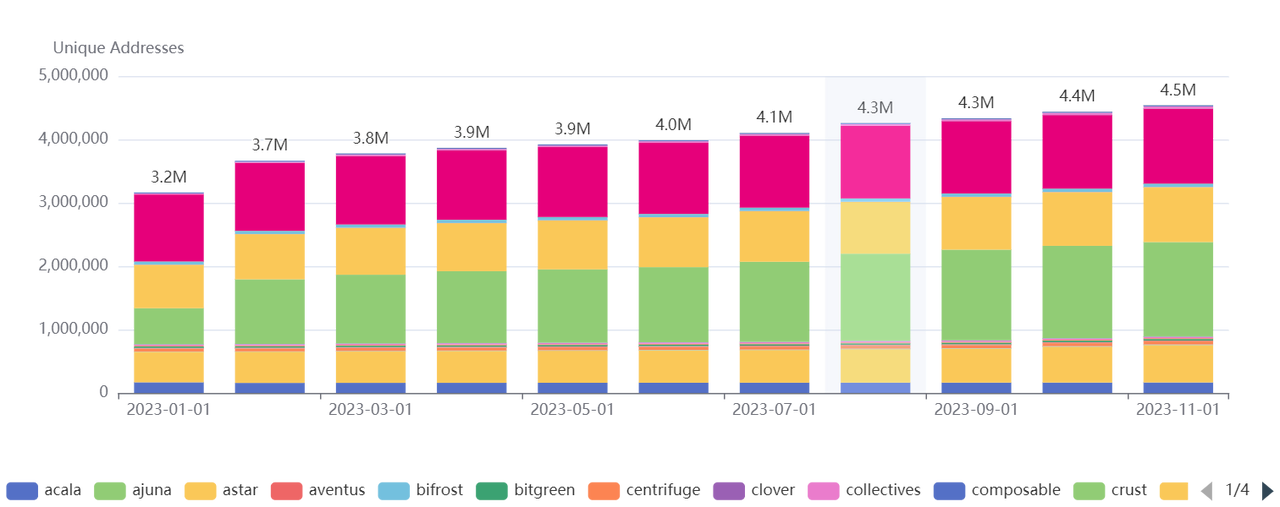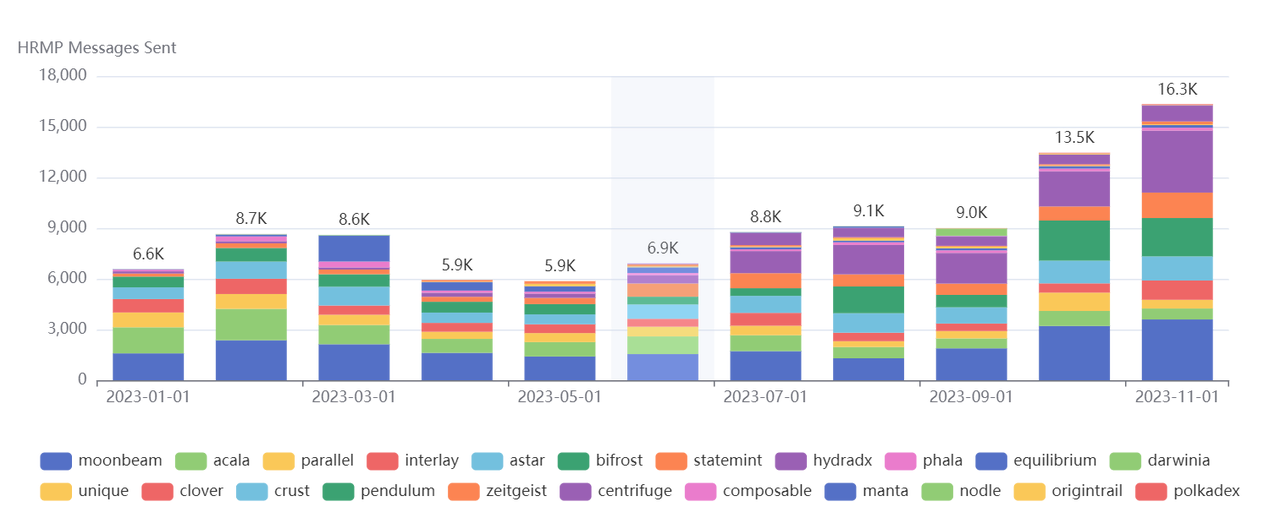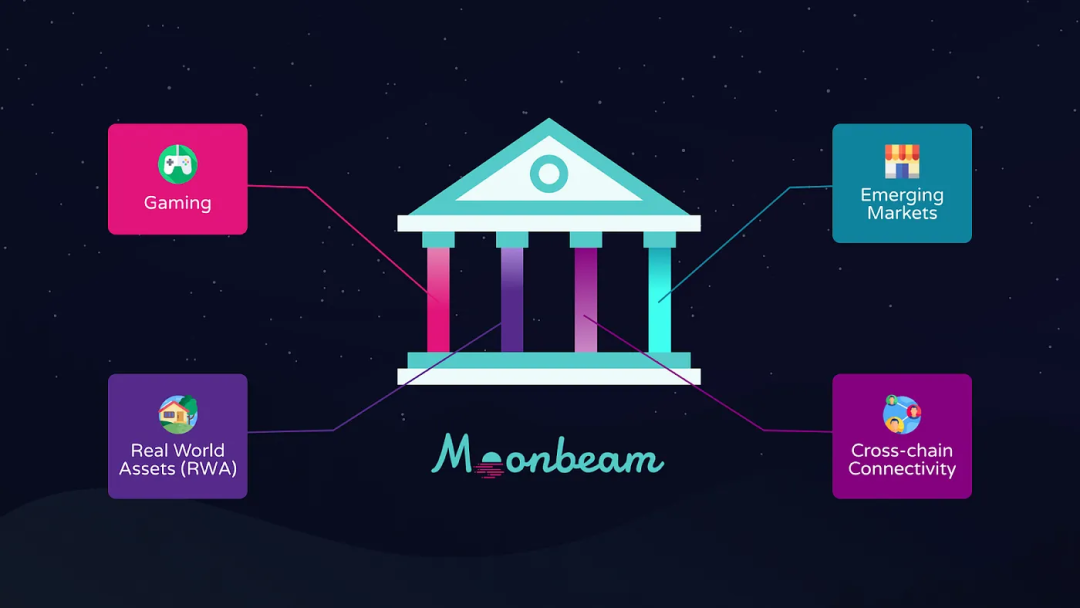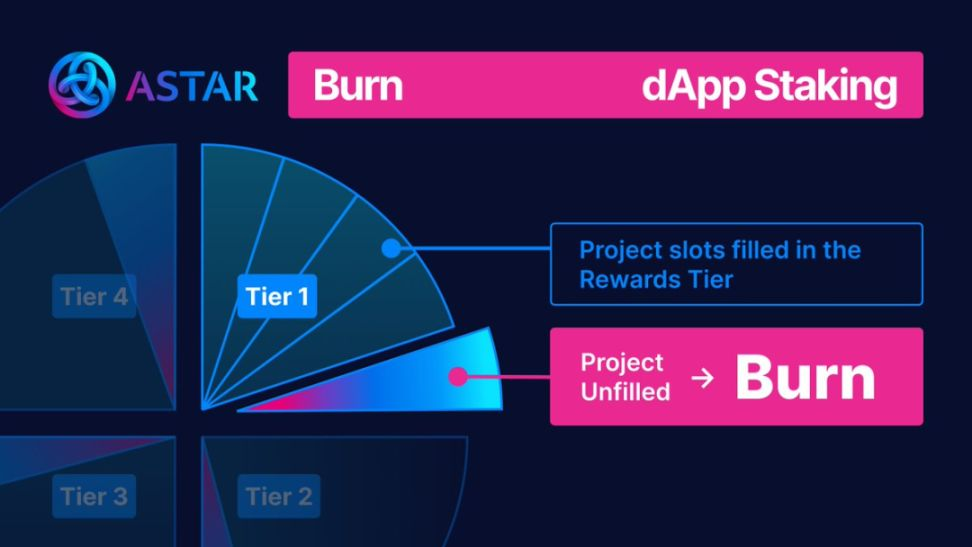From Moonbeam to Bittensor, understanding the representative projects in the Polkadot ecosystem
Author: DeMan
The long-silent Polkadot network began to show signs of revival on December 20, marked first by a surge in trading volume. On that day, the trading volume on the Polkadot relay chain exceeded 1 million transactions, a remarkable figure. This surge was triggered by an activity known as inscriptions.
In the following two days, the trading volume on the Polkadot relay chain continued to set historical highs. On December 21, the trading volume reached 5,970,000 transactions, and on December 22, it soared to 6,930,000 transactions. These numbers far exceeded any records since 2021, with the previous highest record being only 941,000 transactions, set on May 5, 2021.

Notably, on December 22, Polkadot processed an astonishing 6.9 million transactions, with an average of 416 transactions per block, equivalent to processing 70 transactions per second. This surge in transactions generated 120,000 DOT in fees, of which 96,000 DOT went into the treasury, amounting to a value of $768,000. Even more surprisingly, the fee for a single transaction ranged from 0.01 to 0.017 DOT, equivalent to approximately $0.08 to $0.15 per transaction.
The surge in trading volume triggered by this inscription activity not only represents a numerical spectacle but also showcases the exceptional performance and immense potential of the Polkadot network. Consequently, many investors have begun to believe that the value of the Polkadot ecosystem is severely underestimated.
Looking Back at 2023, Polkadot's Ecosystem Achieved a Series of Positive Developments
2023 was a pivotal year for Polkadot, achieving a series of constructive outcomes, as detailed below:
Establishment of DotLake: 2023 witnessed the establishment of DotLake, a scalable and cost-effective data platform hosted on Google Cloud. The architecture of the DotLake platform has been meticulously designed to optimize the storage and processing of vast amounts of data from over 70 Polkadot and Kusama chains. The emergence of this platform has simplified the handling of all blocks, events, and external factors, significantly enhancing the transparency and accessibility of Polkadot's data.
Launch of OpenGov: In June 2023, the launch of OpenGov transformed Polkadot's governance system, emphasizing direct community control and efficient decision-making. This initiative strengthened the community's position in the development of the Polkadot network and facilitated a more efficient decision-making process. Following the launch of OpenGov, the number of proposals significantly increased.

Release of Polkadot 1.0: In July 2023, the release of Polkadot 1.0 realized the initial vision of heterogeneous sharding and cross-chain communication, marking an important step towards decentralization for Polkadot. Particularly in the financial sector, the launch of native USDC on Polkadot in September enhanced the ecosystem's stablecoin functionality, supporting the development of more financial applications.
High Nakamoto Coefficient: As of November 2023, Polkadot's Nakamoto coefficient reached 93, indicating a very high level of decentralization. This increase reflects the healthy and stable development of the Polkadot network.
Treasury Account Inflows: In 2023, the treasury account received 1.825 million DOT.

- The inflows to the treasury account mainly came from two different forms: bounties and proposals. In 2023, approximately 5.356 million DOT left the treasury in the form of proposals, while 949,000 DOT was paid through bounties. The inflow of DOT into the treasury primarily came from the share of network inflation, with other sources including network transaction fees and miscellaneous transfers from other wallets to the treasury. Overall, the inflow to the treasury account in 2023 significantly exceeded the outflow.

- Growth of Independent Addresses: In 2023, the number of independent addresses grew by 44%, increasing from 3.162 million in January to approximately 4.54 million in November, indicating a continuous rise in the number of users and holders within the Polkadot ecosystem.

- Developer Contributions: Over 800 different developers contributed to Polkadot's codebase weekly, demonstrating the activity and diversity of the developer community.

- XCM v3 Merge: In January of this year, the XCM v3 merge brought advanced programmability, improved bridging, and support for NFTs. Data shows that XCM parachain activity increased by 60% month-over-month, indicating Polkadot's continuous improvements in supporting cross-chain communication.
How Will the Launch of Polkadot 2.0 in the First Half of Next Year Transform the Project Ecosystem? Various Speculations Arise
Developing on the Polkadot ecosystem has always been associated with relatively high costs; however, the anticipated launch of Polkadot 2.0 in the second quarter of next year is expected to bring about significant changes. Polkadot's architecture includes the relay chain, parachains, parathreads, and bridge chains. The relay chain is Polkadot's main chain, responsible for the network's security and ecological governance, but it does not support smart contract functionality. Therefore, the current ways to develop applications on Polkadot are mainly twofold: either becoming a parachain on Polkadot or building applications on a Polkadot parachain.

Becoming a parachain on Polkadot requires participating in slot auctions, which incurs high development costs due to the relatively expensive cost of auctioning slots. The recruitment for Polkadot parachains adopts a staking auction model. For ordinary developers, a more feasible option is to build applications on Polkadot's parachains, which is relatively lower in cost.
According to news from the Polkadot forum, Agile Coretime (Polkadot 2.0) plans to launch the Rococo testnet by the end of the year, followed by the Kusama canary network in the first quarter of next year and the Polkadot mainnet in the second quarter. This means that projects will soon be able to directly access Polkadot relay chain services without the need to rent parachain slots for extended periods. This will significantly lower the barrier to entry for development on Polkadot, thereby invigorating the ecosystem.
Additionally, in November 2023, the Polkadot ecosystem launched a funding project called "Decentralized Futures," aimed at supporting developers within the Polkadot ecosystem. This project will provide a total of $20 million and 5 million DOT in funding, which will be used to support organizations focused on Polkadot, whether for-profit or non-profit projects. This funding support plan will further promote innovation and development within the Polkadot ecosystem.
Overall, the impending arrival of Polkadot 2.0 and the funding support projects within the ecosystem bring more opportunities and potential for the Polkadot ecosystem, while also providing developers and projects with broader development space. This will help drive the rapid growth and prosperity of the Polkadot ecosystem.
A Look at Representative Projects in the Polkadot Ecosystem: From Moonbeam to Astar Network
Here’s a review of some representative projects in the Polkadot ecosystem.
Moonbeam: Creating a Native Ethereum Execution Environment to Reduce Migration Costs for Developers
As a parachain in the Polkadot ecosystem, Moonbeam offers an Ethereum-compatible smart contract platform, which is a highly sought-after feature. Based on the Substrate technology framework, Moonbeam can create a native Ethereum execution environment, providing Web3 RPC and EVM implementations that perfectly align with most DApps (decentralized applications) on Ethereum, saving developers a significant amount of time and money in migration.

Compared to other contract systems in the Polkadot ecosystem, such as Acala, Plasm, and Patract, Moonbeam has demonstrated clear advantages in the following two aspects:
High Applicability and Stability: While many EVM-compatible public chains exist in the market, their stability and security often face various vulnerabilities and challenges. Moonbeam has chosen Froniter as its solution module, placing a high emphasis on compatibility with Ethereum, not just as a slogan. This means developers can confidently build applications on Moonbeam without worrying about compatibility and stability issues.
Attracting Developers and Users: Moonbeam actively supports developers by providing funding programs and Grants acceleration plans, offering both financial and technical support. Additionally, Moonbeam is committed to providing users with a more user-friendly and understandable environment, making the experience of migrating to Moonbeam more comfortable.
In the Polkadot ecosystem, Moonbeam, in collaboration with Parity and OneBlock, hosted the 2023 Winter Polkadot Hackathon, with a deadline of December 22. Moonbeam provided two bounty challenges, one involving the development of LST (vToken) related applications based on Moonbeam's EVM-compatible environment, and the other concerning Web3 gaming projects. The Moonbeam team encourages developers of all project sizes to participate in the competition, and they look forward to seeing various types of Web3 gaming projects, from role-playing games to platform games, bringing more diverse applications to the Polkadot ecosystem.
Moonbeam also offers various precompiles that can be accessed through simple Solidity interfaces, providing developers with powerful functionalities. These precompiles can enhance user experience, such as enabling gasless transactions, batch transactions, randomness, and more. Developers can leverage these precompiles to build outstanding applications on Moonbeam and have the opportunity to win prizes.
Currently, several games based on Moonbeam have gone live, including Moonscape, Evrloot, Playtge, and Blockchain Monster Hunt, enriching the Moonbeam ecosystem and providing users with more entertainment and engagement opportunities. The development prospects of Moonbeam are promising, injecting new vitality into the diversity and innovation of the Polkadot ecosystem.
Acala: Has Burned 80% of Transaction Fees but Introduced a New Burning Mechanism
Acala is a financial services platform built on the Polkadot network, specifically designed to provide a liquidity hub for the Polkadot ecosystem, aiming to drive financial innovation. It offers essential financial functions such as lending and stablecoins for the Polkadot ecosystem. Acala can be seen as the DeFi (decentralized finance) center of Polkadot, as it is the first DeFi protocol developed through Polkadot parachain auctions, providing robust financial infrastructure for the entire ecosystem.
In September 2023, Acala launched the Acala 2.0 plan, introducing Acala Staking and the Exodus network upgrade, while also updating and improving its tokenomics.
ACA is Acala's governance token, and on October 16, 2023, it officially launched the Acala Staking plan through a public vote. This plan aims to set a target annual percentage rate (APR) of 10% for ACA staking and encourages community members to actively participate in staking to enhance the security and governance of the ecosystem.
Additionally, Acala has established new regulations regarding token emissions and burning to create a more balanced ecosystem. According to the new regulations, a total of 100 million ACA will be emitted annually, with 50% of the emissions allocated for ACA staking and the other 50% to help establish liquidity and promote ecosystem adoption. Furthermore, the network will periodically burn a portion of the unused token issuance, such as 1% monthly, as well as a portion of accumulated network fees, for example, 20% through governance. The goal of these measures is to increase the scarcity and value proposition of ACA, which is expected to enhance its value over time.
Acala's continuous development and improvements provide robust financial infrastructure for the Polkadot ecosystem, offering users and developers more financial tools and opportunities. It plays a significant role in driving the decentralized finance revolution and is expected to continue contributing to the prosperity and innovation of the entire ecosystem.
Astar Network: A Multi-Chain Smart Contract Platform Supporting Multiple L1 Blockchains and Various Smart Contract Engines
Astar Network is a parachain built on Polkadot, a multi-chain smart contract project that originated from PALSM and is developed based on the Substrate technology framework. Astar aims to become a multi-chain smart contract platform, designed to support multiple L1 blockchains and various smart contract engines. Developers can build various applications on Astar Network without worrying about scalability and interoperability issues.
Recently, the Polkadot parachain project Astar has entered a new phase, launching the Astar Tokenomics 2.0 Staking burning mechanism. Currently, the Astar network has burned 80% of transaction fees but has introduced a new burning mechanism, namely DApp Staking burning.

Specifically, the DApp Staking burning mechanism categorizes projects based on their value to the Astar network. This means that as the value of the Astar ecosystem increases, projects that gain community support will receive more rewards. This mechanism encourages outstanding developers to actively participate and provides them with greater incentives. However, it is important to note that each layer has a limited number of vacant slots, and if certain slots remain unfilled, the rewards typically allocated to those slots will be permanently burned. This means that unused rewards will be burned, helping to maintain a healthy ecosystem for the Astar network.
Astar Network's founder, Sota Watanabe, revealed that the construction of the STR token economic model 2.0 is two-thirds complete, with the remaining one-third expected to be delivered by the end of the year. Once the new token economic model is activated, the inflation rate of ASTR tokens will be halved, and the network will introduce a new DApp staking mechanism. These measures are expected to inject more vitality into the long-term development of Astar Network and promote the prosperity of its ecosystem. These changes will help ensure that Astar Network continues to thrive within the Polkadot ecosystem and provide innovative financial solutions.
DePin Projects Hold an Important Position in the Polkadot Ecosystem, with a Series of Innovations Worth Noting
Recently, the market has been buzzing about a series of DePin projects, and the DePin projects within the Polkadot ecosystem have unique advantages and prospects. DePin projects refer to decentralized hardware network projects, typically involving the construction of both blockchain networks and hardware device networks. For the hardware device network, a special consensus mechanism is usually required to evaluate participants' support for the hardware network and allocate corresponding rewards.
Among the existing chain launch tools, such as Polkadot's Substrate framework, Cosmos's Cosmos SDK, and OP Stack and other Layer 2 chain launch tools, the Substrate framework is one of the few tools that can provide the most comprehensive and customizable chain launch capabilities. It does not restrict developers to a specific consensus mechanism, allowing them to use custom consensus mechanisms and quickly build a blockchain, a feature that aligns closely with the needs of DePin projects. Therefore, the Polkadot ecosystem can spontaneously give rise to more DePin projects, and compared to other multi-chain ecosystems, the Polkadot ecosystem has greater potential in this area.
Here are some DePin projects that have garnered significant attention in the Polkadot ecosystem:
Bittensor: Promoting Collaborative Training of Machine Learning Models in a Distributed Environment
Bittensor is an open-source protocol that supports a decentralized, blockchain-based machine learning network. The project aims to promote the collaborative training of machine learning models in a distributed environment and allocate rewards based on the information value they provide to the entire network. Bittensor's goal is to accelerate the development of artificial intelligence through an incentivized, iterative ecosystem that enables model interoperability and information sharing, fostering a more equitable and collaborative approach to ownership and access control. The project's vision is to create a fully decentralized AI marketplace that provides an open, trustless environment for producers and consumers of valuable goods.
Deeper Network: A Network Security and Privacy Protection Infrastructure Project Based on Blockchain Technology
Deeper Network is a blockchain-based network security and privacy protection infrastructure project aimed at providing users with a freer, safer, and more private way to connect to the internet. The project utilizes blockchain protocols, advanced network security technologies, and the Substrate development framework to lay a solid foundation for the development of the Web3.0 ecosystem and the future internet. The core technologies of Deeper Network include AtomOS (a lock-free network security operating system), Trident Protocol (a decentralized communication protocol), and NPoW (next-generation proof of work mechanism). The project has also launched hardware products, such as Deeper Connect, which is the world's first blockchain-based home network security hardware, aimed at achieving decentralized private networks and bypassing internet censorship.
The emergence of these DePin projects provides new opportunities and prospects for the development of the Polkadot ecosystem, while also bringing innovation and possibilities for the development of decentralized networks and hardware devices. They will continue to drive the growth of the Polkadot ecosystem and provide users with more choices and security. The successful development of these projects will help Polkadot ecosystem occupy a more important position in the decentralized network field.
Will There Be New Narratives in Cross-Chain Ecosystems in 2024? Let’s Look at a Series of Technical Developments in the Polkadot Ecosystem
The Polkadot ecosystem is entering an exciting phase of development. From the surge in network transaction volume to the continuous emergence of DePin projects, the vitality and innovative potential of the Polkadot ecosystem cannot be overlooked. In the annual progress, we have seen a series of important milestones, such as the establishment of DotLake, the release of Polkadot 1.0, and the launch of native USDC, all of which have laid a solid foundation for the prosperity of the Polkadot ecosystem.
The upcoming Polkadot 2.0 version heralds significant changes that will lower the barriers for developers and further invigorate the ecosystem. Projects like Moonbeam, Acala, and Astar Network showcase the diversity and innovation of the Polkadot ecosystem, providing rich solutions across different fields. Meanwhile, the emergence of DePin projects offers new prospects for network security and decentralized hardware devices.
In summary, the future of the Polkadot ecosystem is filled with opportunities and challenges. We look forward to seeing more interesting projects and developments, while also hoping that the ecosystem can continue to maintain a neutral and open attitude, providing more possibilities for global innovation and collaboration. The upward momentum of the Polkadot ecosystem is becoming increasingly evident, and we will closely monitor its future development.









